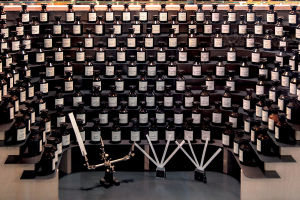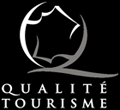
Immediately to your left, you can look at the perfumers’s organ. It is so called because it looks just like an organ but also because it is aimed to contain essences also called notes. About 3000 notes exist and most of the perfumers knows 2 to 300 by heart and mainly work with those to compose an olfactive symphony.
Notes are divided into three categories: the head notes last the shortest time and are the introduction of the perfume; the heart notes give the perfume its identity and personality; and the base notes, or “sillage”, the trail, are the deepest and more fixative notes.
We still have a remaining question: how does one extract all these notes? Turn around to discover some of the methods.
There are several extraction methods but the most famous one is distillation. Water is poured at the bottom of the copper alembic and above it a perforated basket with the raw material is placed. We boil the water that changes into steam that passes through the raw material, capturing the scent molecules. The steam then goes into the gooseneck and the serpertin to cool down. It then condensates to a liquid made of floral water and essential oil. Oil floats on top of the water and it can be pulled apart. For more fragile plants, another technique was invented in Grasse in the 18th century: enfleurage à froid. It consisted in spreading a layer of animal fat on top of a glass panel held by a wooden frame like the ones you can see here. Then they would put flowers one by one by hand on the fat, leave them overnight, and repeat in the morning with fresh flowers. They would do this everyday for a month. By the end of that time, the fat was saturated with smell. It would then be whisked with alcohol to get the absolute. This method is no longer used for obvious time and cost reasons. It has been replaced by other method like volatile solvent extraction for example.
On the various screens in the room, you can discover our artisanal production carried out in our three factories located in Grasse and Eze in the south of France. Perfumes, cosmetics, and soaps have been the know-how of Maison Fragonard for 4 generations and we are happy to continue producing them in France.
This audio-guide is coming to an end, we hope you enjoyed this historic stroll which we invite you to continue with an olfactory discovery downstairs. The Fragonard team will be happy to answer your questions and help you.
Have a lovely day and see you soon!
FRAGONARD PARFUMEUR
A family business with ancestral know-how, Parfumerie Fragonard was founded in 1926 in the town of Grasse.
THE FRAGONARD BLOG
Get all the latest news about our factories and museums and experience the world of Fragonard.


